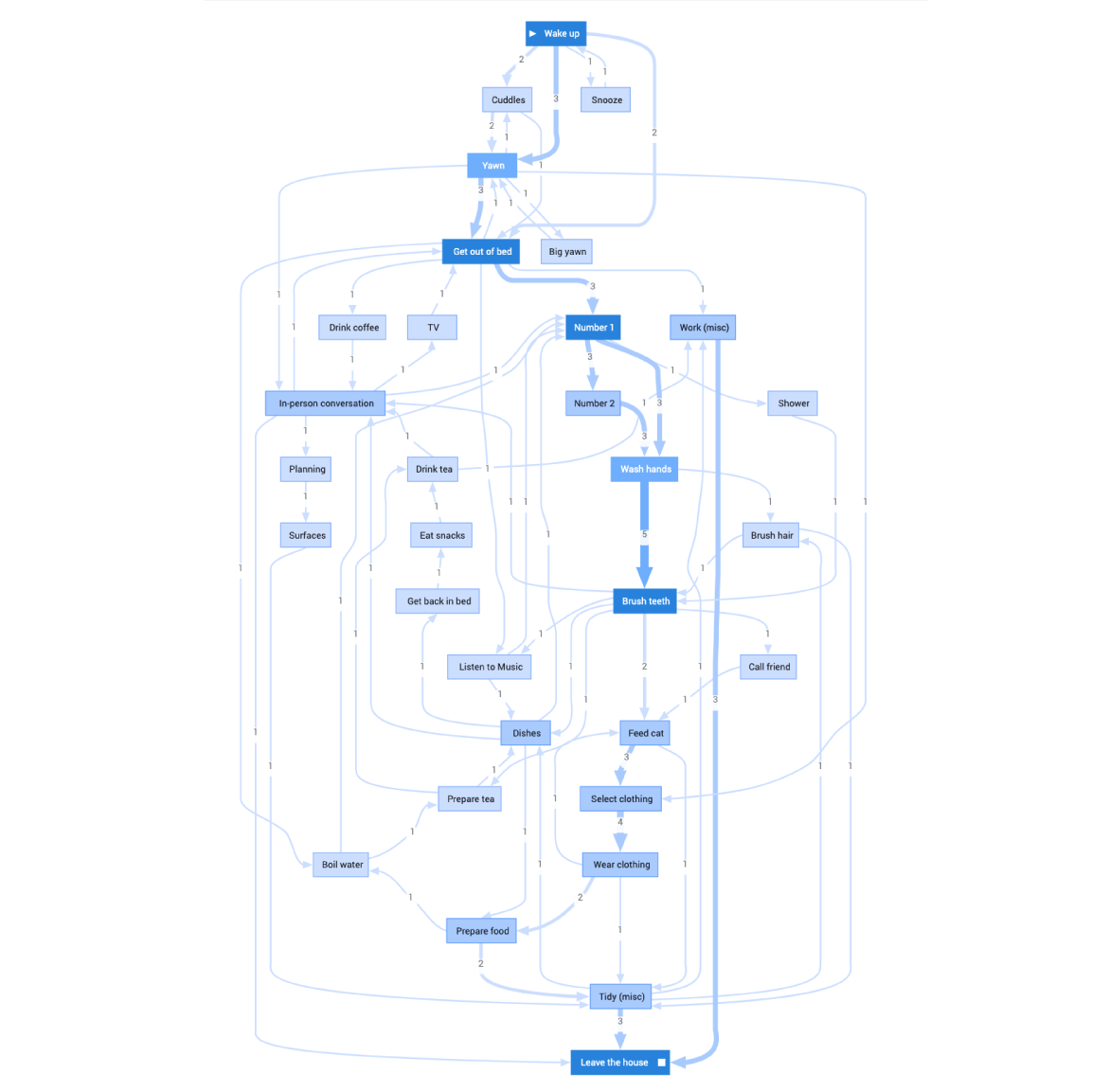How I Optimized My Morning Routine with Process Mining and Automation
Share at:

It may be a strange thought, but have you ever considered your morning routine to be a process? And a process that could be improved with process mining?
The definition of a process is a series of actions, events, or tasks that are carried out in a certain order to achieve a specific goal. So, for the sake of argument, let’s consider your morning routine a process. You wake up, roll over once or twice, and probably hit the snooze button before eventually getting out of bed to start your day.
In this case, which is similar to most other processes, these events are linked, and the tasks within the overall process must follow a certain order. For example, you can’t brush your teeth without getting out of bed first.
Also, while many of the tasks are the same, each morning can be unique. You may get out of bed on time 99% of the time, but inevitably, there is that one day where you’re just not feeling well and may stay in bed all day.
Similarly, there are other mornings where you may sleep through the alarm. But on other days you may get up early to exercise or meditate. These slight deviations make each day unique and represent slightly different ‘processes’ that you may not even be aware of.
Improving daily routines with process mining
What if one day you woke up with an intense desire to understand your morning routine each day and possibly even identify opportunities to make it much more effective? I did exactly that with UiPath Process Mining! The results were interesting, so I thought I’d share this example to show just how effective process mining can be.
I started by using Google Forms to create a questionnaire to record each day’s activities and their specific timestamps. After just a week, I had the initial results I needed to examine my morning routine. More importantly, I could begin to objectively analyze it as a business process using UiPath Process Mining.
Process mining takes existing data and uses specialized algorithms and visualization dashboards to analyze and then visually depict this data using process graphs to provide valuable new insights. After plugging in data—even just the small sample of one week’s worth of my morning routine data—users will see a graph that begins to reveal trends and tell the overall story behind a process.
Filters and other tools can help users model variables, such as a rare morning activity, to present an accurate, high-level overview of the whole process.
New insights
Back to my example. In this case, the first, high-level view showed that I was capable of following an ideal morning process. I wake up, get out of bed, go to the bathroom, and then perform small tasks such as feeding my cat, before heading off to work. This initial overview also revealed other aspects of my routine, including the fact that I rarely eat breakfast at home on workdays.
Yet I knew something was not quite right and suspected that there could still be missing information that would be helpful in improving my efficiency and productivity each day. With UiPath Process Mining, I could take a closer look at my tasks and how long they took, and quickly found my biggest challenge. Or to look at it more optimistically, my biggest opportunity for improving my process.
It turns out that the biggest chunk of time each day fell under the category of “leaving the house.” This is understandable since I do spend a fair amount of time getting ready and organized before leaving the house. Yet more concerning was the revelation that the total time it took me to get out of bed—including discrete timestamped tasks such as “wake up,” “yawn,” “roll over,” “hit snooze,” and “get out bed”—was much longer than I would have wanted.

It was valuable information since the process mining visualization confirmed what I already knew—that I waste too much time before getting out of bed each day—yet it presented objective data in a way to help me begin to understand why this was happening.
Uncovering true root causes
Process mining digs deeper than what metrics such as averages might show. For example, on average, it took the me 12 minutes to get out bed, which may seem reasonable. Yet data on those outlier days told another story. By drilling down into each day’s data, I could see that on one particular day, it took me more than an hour to get up and moving, which could be more of an issue.
This number surprised me so I investigated it further. I learned that the purported oversleeping incident happened because I woke up too early and then waited until the very last minute when my alarm went off. While this event was not the problem it might have seemed—I was not actually late for work—all of this evidence clearly showed that the biggest bottleneck to my day was the time spent getting out of bed.
Additional insights
Process mining told me even more. Using additional visualizations, it seemed that Saturday was the slowest wake-up time on record: a full 43 minutes of sleeping in. (Maybe the result of attending a much needed "decompression" event the night before?).

Counterintuitively, the fastest morning occurred on a Sunday. I admit that I wouldn’t have expected this and at first, I couldn’t remember why, especially since I didn’t even set an alarm. After further thought, I realized the real reason: my partner made coffee, and I couldn’t bear the thought of it going cold, leading me to get up faster than normal.
Creating new results
Without process mining, I never would have known any of this. Yet now the question remained: How could I use this data and these new insights to actually improve my morning routine? Or more specifically, how could I replicate my most successful day—my most ideal process—and minimize the amount of time it takes me to get out of bed each day?
My instincts told me there was a correlation between coffee and my desired results, but I also knew it would not be realistic to ask my partner to make me coffee each day. So Instead, I came up with a different solution: an automatic coffee machine. Problem solved!
While this example, is not a true digital workflow—and not one that can be solved with robotic process automation (RPA)—it is fitting that automation was the answer. In most cases, process mining and RPA go hand in hand in visualizing process improvements and then automating the tasks to achieve the results.
We hope this example helps you see how process mining can help improve work-related processes in your organization (and maybe your morning routine, too!).
Want to learn more? If you only have a couple minutes, watch the video below. If you have more time to dive deeper you can download our white paper: Accelerating RPA with End-to-End Process Understanding and Monitoring.


Founder, Dembrane
Get articles from automation experts in your inbox
SubscribeGet articles from automation experts in your inbox
Sign up today and we'll email you the newest articles every week.
Thank you for subscribing!
Thank you for subscribing! Each week, we'll send the best automation blog posts straight to your inbox.



